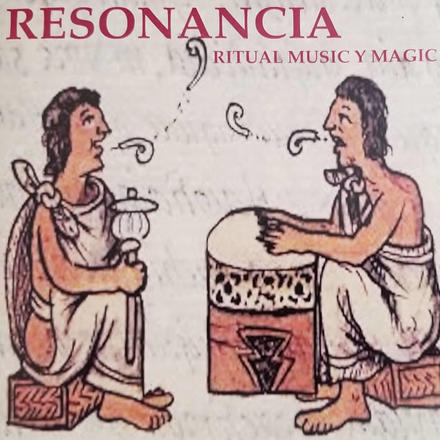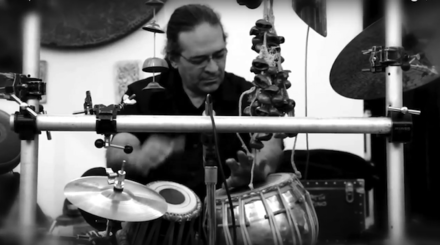"Resonancia," the new album from Christopher Garcia's Orquesta Indigena, lives up to the name on every level -- sound, spirit and concept. The low drum vibrations can make you feel the heartbeat of a sleeping dragon. The high rattles can sound like a dance of skeleton elves. The wooden and clay flutes raise images of ancient Mesoamerican temples, while some of the female vocalizing draws you inside a cathedral -- and if you've been in a Mexican or Peruvian cathedral, you know how thoroughly the conquerors' religion was transformed by indigenous influences. Some of the beats even carry the universality of the blues. We hear calls to action, the threat of war, a reverence for peace. Although spiritual music with a quiet ambiance often gets called New Age, the term does not apply here. This is Auld Age music. Very, very auld. (Listen/buy here. All proceeds go to an indigenous-arts organization.)
* * *
People tell Christopher Garcia he has a very strange career. "I never thought of it as a career," says the interpreter of many instruments (especially drums) from around the world. "I am blessed to only play the music I want to play. I don't take gigs for money." He laughs, but he's serious.
Garcia makes few distinctions among musical forms. He says he listens to as much Hank Williams as John McLaughlin. In addition to his own projects, Garcia has collaborated on Frank Zappa music (The Grande Mothers), Indian music (L. Shankar), avant-garde jazz (Michael Vlatkovich, Bobby Bradford) and fusion (Continuum, Michael Manring), among many others. He has never stopped, except for a couple of weeks in 1994, when he experienced a brain aneurysm and was given a week to live. Refusing surgery, he walked out of the hospital to receive acupuncture treatments and drink putrid tea. His headaches and fever vanished, never to return.
Below, Christopher Garcia tells MetalJazz the epic story of how he got started in music.
* * *
As a teenager I was looking at an album called "Festival From India," performed by a traveling group that Ravi Shankar had brought that went across the United States. It was 16 musicians that played different configurations in two nights, and there was a tabla solo and a group solo, and I was, like, "What is that?" So I told my parents, "I want to study this." And my father said, "What? Where?!"
My high-school counselor found Wesleyan University in Connecticut, UCLA and Cal Arts. Wesleyan was too cold. UCLA was way too big. Then I visited CalArts, and it was like, "Whoa, this is interesting." At that time there were around 375 students. There was no jazz department, just composition, performance and world music. There were, like, six percussionists, and now there are 60.
God bless John Bergamo. I called John, the head of the percussion department at CalArts, and I said, "I have been playing drums for years." That is, I had been playing parties and backyard barbecues in East L.A. all through the mid-'70s. People would get stabbed, shot or killed at some of these gigs -- you don't know the meaning of a tough room.
Guys had been lending me cymbals. They were doing Steely Dan, Beatles, Led Zeppelin, Edgar Winter, all kinds of weird stuff. The drummer Richard Luna would sit behind me and look at my feet, and he said, "My drums are here for you if you ever want to play." I'd watch the other guys, who were all five or six years older than me, and they'd rehearse twice a week, for hours. They were great -- they played everything, and it sounded just like the record!
Anyway, I called John Bergamo and said, "I want to study tabla." And he said, "If you want to study a percussion instrument here, first you have to play a melodic instrument." I'm, like, 16. "What do you mean, sir?" "Please don't call me sir," he said; "you know, violin, saxophone." "I don't play any of those, and I just own four drums. I've been playing six years, and my parents don't have any money for lessons. I just play by ear."
He said, "Where do you live?" "East L.A." Silence. "Is there a junior college by you? Go and take every class you can take -- music appreciation, music history, theory, harmony, and call me when you're done."
I told the music teachers at East L.A. Community College, "I have a year to prepare to go to college," and they took me on. They took me to the band room and let me play a beat-up xylophone, which looked like somebody had taken a ballpeen hammer to it. They said, "We close at 8. Close the door on your way out, and let the janitor know." I did that for a year -- learned chords, learned how to read music. I'm 18; this is the late 1970s.
Then I went up to CalArts. Most people auditioned months before, but I auditioned the day of registration. Not ready, not ready, and scared to death! So John Bergamo stood outside the door and watched me practice. I didn't know people prepared all of these pieces, with all these multipercussion setups. I just wanted to play tabla. So John said, "Play a scale in C major." I said, "Do you want it in 16ths, triplets, arpeggios?" "You can do all that?" "Yes, sir." "Call me John. You can use all your scales?" "Yes." "Play the G-sharp harmonic minor scale in two octaves, starting on the seventh degree and going down to the tonic." I did. "Okay, play something you know." I played "Thousand Island Park" from Mahavishnu, I played "Spain" from Chick, and I played "Meeting of the Spirits" from Mahavishnu.
He pulled up the sheet music for "Telemann Flute Duets," and I just massacred it, couldn't read to save my life. John started walking out of the room without saying a word, and I thought I had failed. When he hit the doorknob, I asked him, "What happens now?" God bless him, John said, "You have ears. You can't teach ears. The reading, that's a skill, we can bring that up. Go upstairs and register." I went on full scholarship.
I was one of maybe three Hispanics in the school, and the others were not from L.A., and maybe 30 percent of the students were from another country. I was very out of my world.
When I moved up to Valencia I was sleeping in practice rooms, sleeping on people's floors. I lived in a house with five people for a minute, and whatever food I had would be gone. So I would buy, like, three pounds of raw Serrano chiles and jalapenos, and dozens of tortillas and water. Nobody ate that but me! I could leave it there, and I knew it was gonna be there when I got back. I had no car, and it was really interesting.
My grades were really good the first year, and then I just started working, working. The second year I started missing so much school because I was working -- playing rock, jazz, fusion. And John said, "What do you want to do?" "I want to play my instruments to the best of my abilities, and learn from the best people I can." And he said, "You don't have to go to school to do that. When I do a gig, nobody asks me for a piece of paper."
John is my mentor, and we became very close friends. He has passed, but by the grace of God, my family, and every teacher and mentor who shared so tirelessly with me, I'm still here. I try to make use of every second.
* * *
In January of 2020, Garcia was invited to present his music at the Radcliffe Institute of Advanced Study at Harvard.


